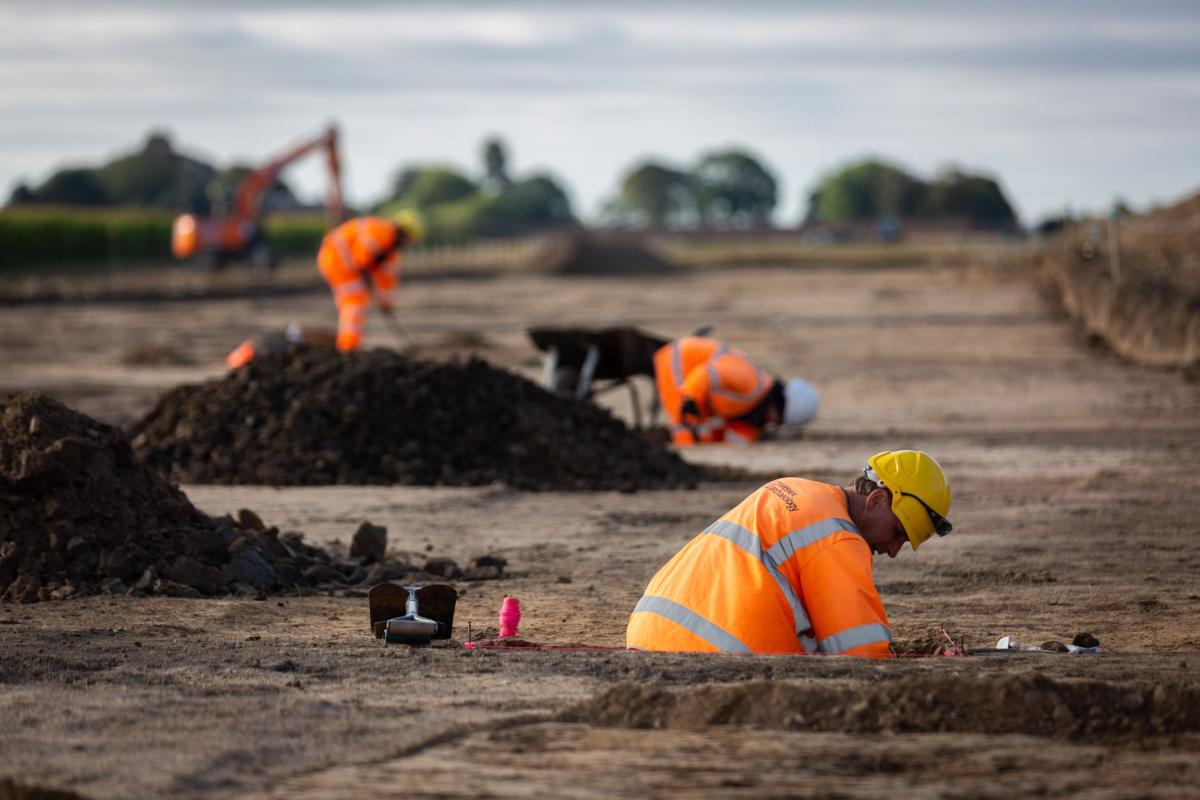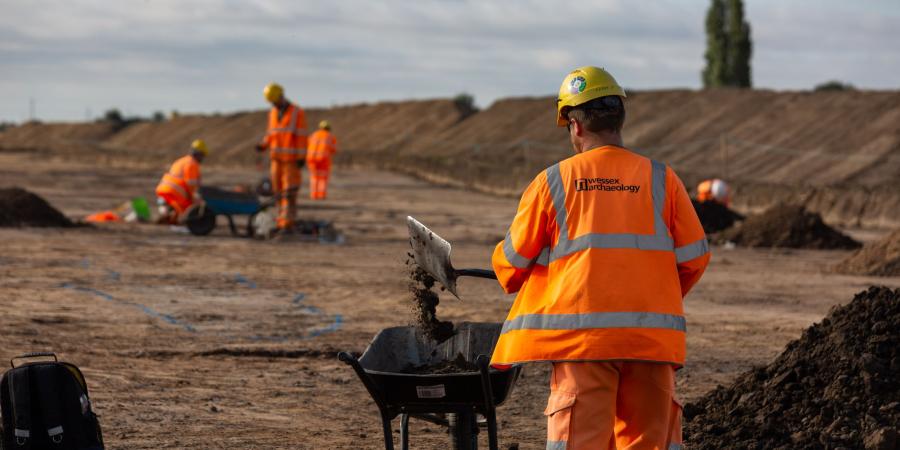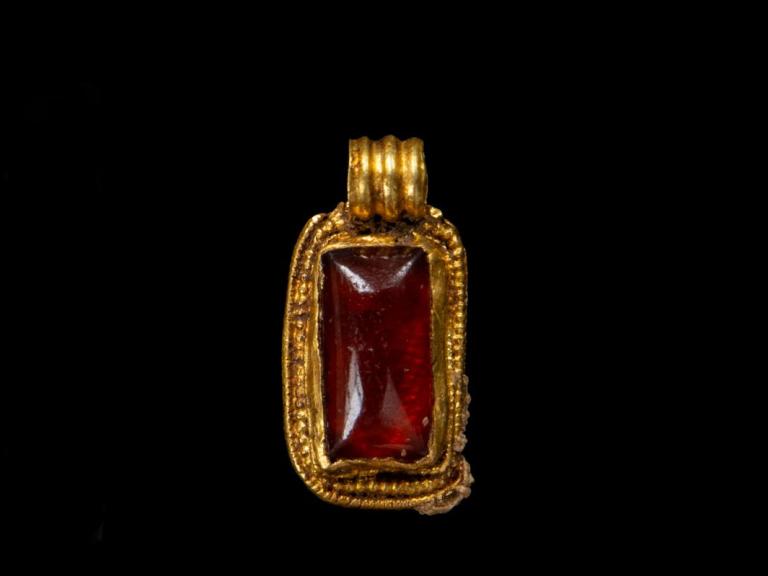52.90623616506, -0.21268844604492
Project summary
- Client: Balfour Beatty on behalf of National Grid Viking Link Ltd
- Location: Lincolnshire
- Project duration: January 2021 - operational
- Sector: Renewable energy
Key facts
- The Viking Link interconnector began operating on 29th December 2023
- This £1.7 billion project is a joint venture between National Grid and Danish operator Energinet, and has the capacity to power up to 2.5 million UK homes
Commissioned by Balfour Beatty, Wessex Archaeology undertook archaeological investigations to support construction of the new Viking Link Interconnector, which transmits electricity between Britain and Denmark. It is the world’s longest land and sea electricity cable, spanning 475 miles, and connects Bicker Fen substation in Lincolnshire with Revsing substation in southern Jutland, Denmark. The onshore route within Lincolnshire was divided into three zones based on landscape character: the Lincolnshire Marsh, the Wolds and the Fens.

Above: Significant discoveries at the site include Bronze Age barrows, Romano-British settlements and an Anglo-Saxon cemetery.
Supporting the renewable energy sector with archaeological work
Our first course of action was to undertake trial trenching to test for the presence of archaeology, with over 200 trenches excavated. Using the results from this trial trenching we planned and undertook a programme of archaeological work. This involved the excavation of 38 sites of archaeological interest. This work was undertaken in accordance with the relevant Written Schemes of Investigation, detailing the aims, methodologies and standards to be employed for both the fieldwork and post-excavation work.
All the archaeological features and deposits were recorded using Wessex Archaeology’s digital recording system. A complete record of excavated features and deposits was made, including plans and sections drawn to appropriate scales and tied into Ordnance Survey’s National Grid.
Within the Fenland section, our geoarchaeology experts undertook a borehole survey to improve our understanding of the presence, nature and distribution of sediments and palaeoenvironmental sequences. A total of 29 geoarchaeological boreholes were drilled and combined with information from earlier surveys, including our evaluation trenches in the Fens, to form a deposit model.
Aerial photography was collected using an unmanned aerial vehicle (UAV) for the purpose of producing detailed topographic datasets of certain excavated areas. These datasets could also create 3D photogrammetry models of archaeological features.
In addition, photogrammetric recording was used to record the inhumation burials uncovered in one area for detailed 3D models and orthomosaic images.
Specialist input reveals the history of a largely unexplored area of Lincolnshire
Until this project began, southeast Lincolnshire was something of an archaeological mystery, with fewer investigations having taken place than in other parts of the country. Our experts have helped piece together the history of this rural area and in turn, made an important contribution to the archaeological record.
During the archaeological works, we discovered a variety of significant remains including a Bronze Age barrow and evidence of Romano-British settlement patterns. The most striking discovery, however, was that of an Anglo-Saxon cemetery. Our archaeologists found the remains of 23 individuals along with grave goods including knives, jewellery and pottery vessels. The burials were carefully and sensitively excavated under the terms of our Ministry of Justice licence and examined by our in-house osteoarchaeologist. The grave goods and radiocarbon dates revealed that the cemetery was used during the 6th and 7th centuries AD.
In total, more than 500kg of artefacts were recovered from the route, the majority of which date from the Romano-British period. Most finds were recovered by hand during the normal course of excavation but owing to the waterlogged nature of the site, our finds processors diligently extracted some of the tin finds from the residues of samples taken for the recovery of environmental remains. All finds were quantified and cleaned and made ready for specialist analysis.
Analysis of the findings is underway and will be made available both as a print-on-demand book and free-to-download pdf through Wessex Archaeology’s online library. The finds and records will be given to Lincoln Museum for safekeeping where they will be available for future study.
Weaving animation and archaeological results together, we produced a short film about the site for community and project stakeholder events.
Engaging project stakeholders in the archaeology of the scheme
We worked closely with the National Grid Viking Link team to produce an educational booklet, Alfie and the Archaeologist, for school children. The book centres on two main characters and is designed to help young people, aged seven to 11, learn about renewable energy and the Viking Link Interconnector. Together with National Grid and Mad Science, we toured partner schools in Lincolnshire to deliver educational activities to more than 425 children.
We also supported National Grid with stakeholder engagement, contributing archaeological content and expertise to community and project stakeholder events.
Notably, the project featured on the BBC’s flagship archaeology series Digging for Britain, which showcases significant excavations around the UK.

